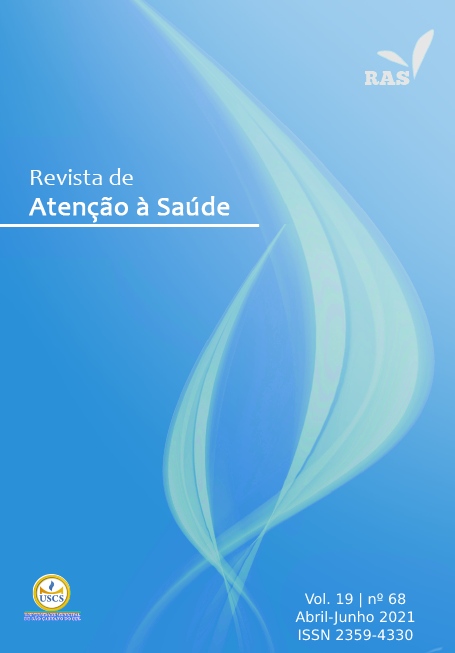Análise epidemiológica do COVID-19 no estado de Minas Gerais
DOI:
https://doi.org/10.13037/ras.vol19n68.7655Palavras-chave:
Coronavirus, Epidemiologia, PandemiaResumo
Introdução: A pandemia do Coronavírus afetou diversos países ao redor do mundo em um curto espaço de tempo. Foi identificado pela primeira vez no Brasil em fevereiro de 2020 e, desde então, o número de casos e de óbitos aumentou consideravelmente. Assim, compreender o perfil populacional da doença quanto às localidades e vulnerabilidades faz-se necessário para um controle epidemiológico mais específico. Objetivo: Descrever o perfil epidemiológico do COVID-19 no estado de Minas Gerais no período de março a outubro de 2020. Métodos: Estudo quantitativo, descritivo, de base documental com procedimento comparativo-estatístico. Os dados acerca dos casos e óbitos confirmados de SARS-CoV-2 no estado mineiro foram coletados a partir dos boletins epidemiológicos disponibilizados pela Secretaria de Estado de Saúde de Minas Gerais pela plataforma Coronavírus Minas Gerais. Resultados: Foram registrados 346.310 casos de COVID-19 no período, com maior prevalência no sexo feminino (51%) e na faixa etária de 30 a 39 anos (24,3%). Quanto aos óbitos, 8.916 foram confirmados, com maior frequência em homens (57%) e em pessoas com mais de 60 anos (79,52%), sendo as comorbidades mais presentes as cardiopatias (47,77%) e o diabetes (33,28%). Conclusões: Verificou-se prevalência de casos no sexo feminino e na faixa etária entre 30 e 39 anos, enquanto os óbitos foram mais frequentes em homens e na faixa acima de 60 anos. Ainda, foi possível visualizar a relação das políticas públicas com os números de infecções e de mortes, reforçando a necessidade de adequação e direcionamento de estratégias para o controle do COVID-19 no estado.
Downloads
Referências
BRASIL. Ministério da Saúde. Boletim COE Covid-19. Brasília – DF, 2020.
Ferreira Netto RG, Corrêa JWN. Epidemiologia do surto de doença por Coronavírus (CO-VID-19). Revista Desafios. Palmas, v. 7, p. 18-25, 2020. Suplemento COVID-19.
Neerukonda SN, Katneni UA Review on SARS-CoV-2 Virology, Pathophysiology, Ani-mal Models, and Anti-Viral Interventions. Pathogens. V. 9, n. 426, p. 1-22, 2020.
Maciel EL, Jabor P, Gonçalves Júnior E, Tristão-Sá R, Lima RCD, Reis-Santos B, Lira P, Bussinguer ECA, Zandonade E. Fatores associados ao óbito hospitalar por COVID-19 no Espírito Santo, 2020. Epidemiologia e Serviços de Saúde. Brasília, v. 29, n. 4, p. 1-11, 2020.
Magalhães SCM, Santos FO, Lima SC, Fonseca ES. Situação Epidemiológica da Transmissão da COVID-19 no Norte de Minas Gerais, Brasil. Revista Brasileira de Geografia Médica e da Saúde. Uberlândia, p.80-87, jun de 2020. Edição Especial.
Hu B, Guo H, Zhou P, Shi ZL. Characteristics of SARS-CoV-2 and COVID-19. Nature Reviews. V. 19, p. 141-154, 2021.
Lazarus JV, Ratzan SC, Palayew A, Gostin LO, Larson HJ, Rabin K, Kimball S, El-Mohandes A. A global survey of potential acceptance of a COVID-19 vaccine. Natura Public Health Emergency Collection. V. 27, n. 2, p. 1-4, 2021.
ACHA. American College Health Association. Guidelines - preparing for COVID-19. Silver Spring: ACHA Guidelines, 2020.
Gomes GGC, Bisco NCB, Paulo MF, Fabrin SCV, Fioco EM, Verri ED, Regalo SCH. Perfil epidemiológico da Nova Doença Infecciosa Coronavírus - COVID-19 (Sars-Cov-2) no mundo: Estudo descritivo, janeiro-junho de 2020. Brazilian Journal of Health Review. Curitiba, v. 3, n. 4, p. 7993-8007, 2020.
Lima SC, Fonseca ES, Santos FO. Situação epidemiológica e difusão da COVID-19 pela rede urbana em Minas Gerais, Brasil. Revista Brasileira de Geografia Médica e da Saúde. Uberlândia, p.243-250, Jun./2020. Edição Especial.
Rosa MFP, Silva WNT, Carvalho WRG, Oliveira SV. Epidemiologia da COVID-19 em Uberlândia (MG): análise preliminar do impacto do grau de abertura comercial em dife-rentes momentos da pandemia. Journal Health NPEPS. Uberlândia, v.5, n.2, p.20-41, dez, 2020.
BRASIL. Ministério da Saúde. Boletim Epidemiológico Especial. Brasília – DF, 2021.
Neves AGM, Guerrero G. Predicting the evolution of the COVID-19 epidemic with the A-SIR model: Lombardy, Italy and São Paulo state, Brazil. Physica D. Utrecht, v. 413, p.1-12, 2020.
Mendonça FD, Rocha SS, Pinheiro DLP, Oliveira SV. Região Norte do Brasil e a pandemia de COVID-19: análise socioeconômica e epidemiológica. Journal Health NPEPS. Cuiabá, v. 5, n. 1, p. 20-37, jan-jun, 2020.
Szwarcwald CL, Souza Júnior PRB, Malta DC, Barros MBA, Magalhães MAFM, Xavier DR, Saldanha RF, Damacena GN, Azevedo LO, Lima MG, Romero D, Machado IE, Gomes CS, Werneck AO, Silva DRP, Gracie R, Pina MF. Adesão às medidas de restrição de contato físico e disseminação da COVID-19 no Brasil. Epidemiologia e Serviço de Saúde. Brasília, v. 29, n.5, p. 1-11, 2020.
Escosteguy CC, Eleuterio TA, Pereira AGL, Marques MRVE, Brandão AD, Batista JPM. COVID-19: estudo seccional de casos suspeitos internados em um hospital federal do Rio de Janeiro e fatores associados ao óbito hospitalar. Epidemiologia e Serviço de Saúde. Brasília, p. 1-24, 2020.
Duarte MMS, Haslett MIC, Freitas LJA, Gomes NTN, Silva DCC, Percio J, Wada MY, Fantinato FFST, Almeida WAF, Silva DA, Gava C, França GVA, Macário EM, Baêta KF, Malta JMAS, Alves AJS. Descrição dos casos hospitalizados pela COVID-19 em profissionais de saúde nas primeiras nove semanas da pandemia, Brasil, 2020. Epidemiologia e Serviço de Saúde. Brasília, vol. 29, n.5, p.1-15, 2020.
Lins-Filho PC, Araújo MMS, Macêdo TS, Melo MCF, Ferreira AKA, Silva ELMS, Freitas JLM, Caldas Júnior AF. The impact of socioeconomic vulnerability on COVID-19 outcomes and social distancing in Brazil. SciELO Preprints.
Lima NT, Buss PM, Paes-Sousa R. A pandemia de COVID-19: uma crise sanitária e humanitária. Cadernos de Saúde Pública. Rio de Janeiro, vol. 36, n. 7, p.1-4, 2020.
Carvalho EA, Carvalho RA. COVID-19: Time-Dependent Effective Reproduction Number and Sub-notification Effect Estimation Modeling. MedRxiv Preprints. 2020.
Corrêa PRL, Ishitani LH, Abreu DMX, Teixeira RA, Marinho F, França EB. A importância da vigilância de casos e óbitos e a epidemia da COVID-19 em Belo Horizonte, 2020. Revista Brasileira de Epidemiologia. Rio de Janeiro, v.23, p. 1-12, 2020.
Downloads
Publicado
Edição
Seção
Licença
Copyright (c) 2021 Giulia Pacheco Souza, Renato Alexsander Martins Lara, Isabelle Gualberto Souza, Gabriel Felipe Silveira Ferreira, Alexandre Vitor Dias Silveira, Lucas de Las Casas Bessa, Karina Prince

Este trabalho está licenciado sob uma licença Creative Commons Attribution-NonCommercial-ShareAlike 4.0 International License.
Proposta de Política para Periódicos que oferecem Acesso Livre Adiado
Autores que publicam nesta revista concordam com os seguintes termos:
- Autores mantém os direitos autorais e concedem à revista o direito de primeira publicação, com o trabalho licenciado simultaneamente sob uma licença
https://creativecommons.org/licenses/by-nc-nd/4.0/, permitindo o compartilhamento do trabalho com reconhecimento da autoria do trabalho e publicação inicial nesta revista.
- Autores têm autorização para assumir contratos adicionais separadamente, para distribuição não-exclusiva da versão do trabalho publicada nesta revista (ex.: publicar em repositório institucional ou como capítulo de livro), com reconhecimento de autoria e publicação inicial nesta revista.
- Autores têm permissão e são estimulados a publicar e distribuir seu trabalho online (ex.: em repositórios institucionais ou na sua página pessoal) a qualquer ponto antes ou durante o processo editorial, já que isso pode gerar alterações produtivas, bem como aumentar o impacto e a citação do trabalho publicado (Veja O Efeito do Acesso Livre).









